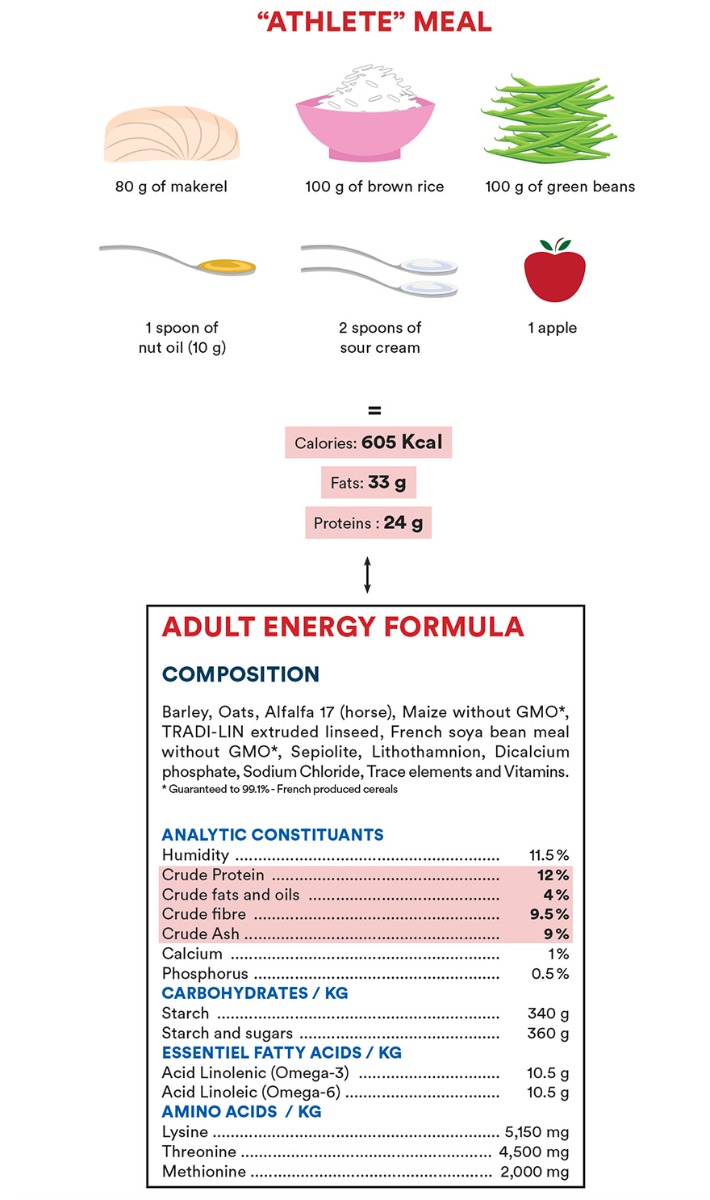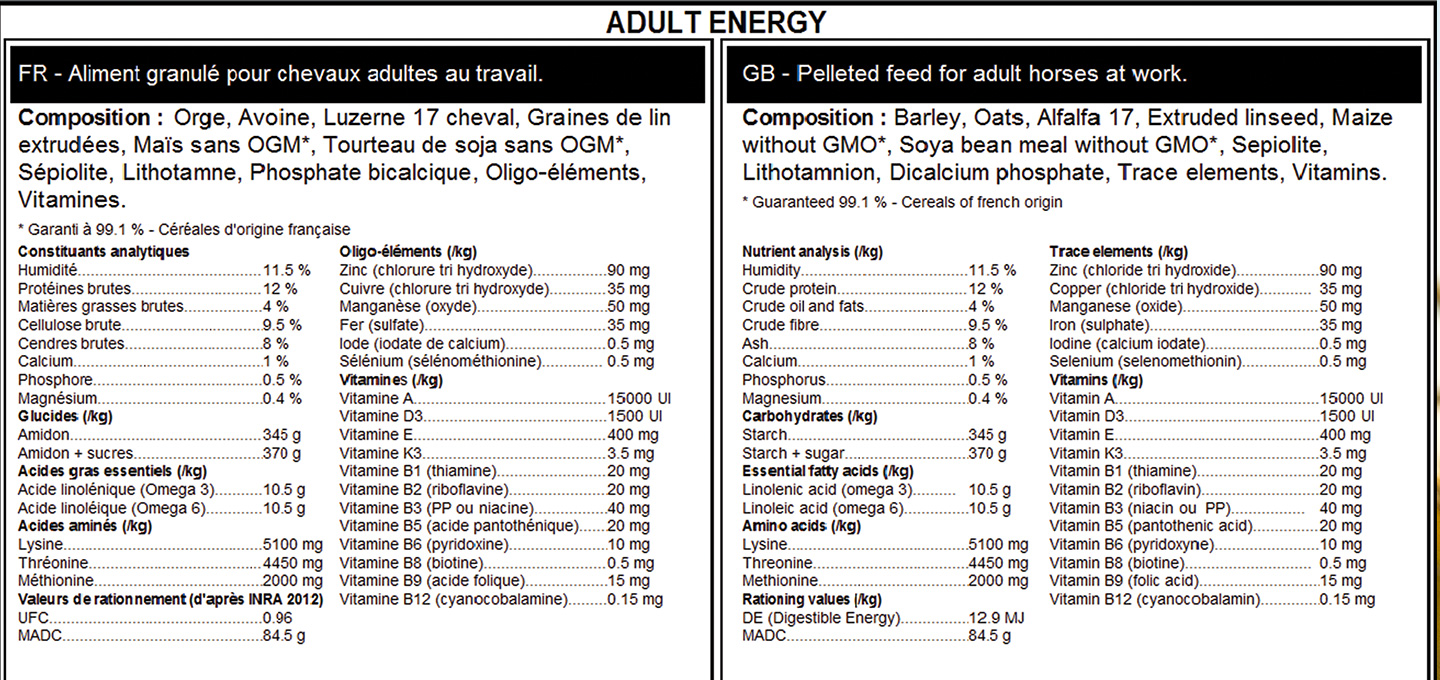How to know if a feed correctly meets the nutritional demands of your horse?
Informations supplied by labels
COMPOSITION
Ingredients are listed by their decreasing level of incorporation (the most to the least).
In consequence, it is recommended to avoid a diet made up of raw ingredients and/or by-products which we have previously mentioned, above all if they are featured in the first lines.
ANALYTICAL CONSTITUENTS
Only the display of certain constituents is obligatory: crude protein, crude oils and fats, crude cellulose (fibre) and crude ash. Mentioning other values is optional (except for particular cases) and engages the manufacturers’ responsibility as to the indicated values.
Whilst, the display of the analytical constituents is obligatory, it actually provides us with little information on the quality of the ingredients. Effectively, the same value for a given constituent can be obtained by using a by-product or a noble raw ingredient. For example, distillers’ spent grains, dehydrated co-products from the fabrication of ethanol contain the same quantity of crude protein as skimmed milk powder, that is to say 34% crude. However the quality of the proteins is far from being identical...
To be aware of the true nutritional value of a feed, we must use the levels of essential nutrients: starch, omega 3 and 6, lysine, etc.
To demonstrate, we have created a feed (fictive and non-commercialised) based upon by-products and declassed raw ingredients (“BY-PRODUCT” FORMULA) of which the obligatory analytical values are identical to ADULT ENERGY.
Victory is prepared at mealtimes too.
ADULT ENERGY's Label
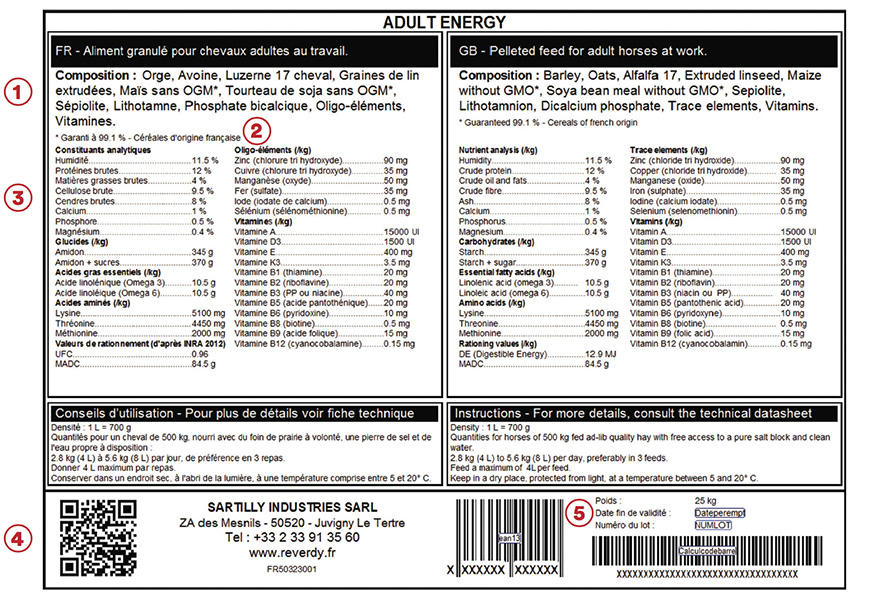
- 1 - Very important
Ingredients are cited by their decreasing level of incorporation (from the greatest amount to the least).
Reverdy feeds contain NO BY-PRODUCTS.
- 2 - Our commitment towards quality at every level:
- Careful following of our raw ingredients.
- A certified manufacturing process.
- 3 -
- The quality of our nutriments is regularly verified by independent laboratories.
- Guaranteed values, from certified suppliers.
- 4 - QR Code read using your smartphone to directly access the technical data sheet for that feed.
- 5 - An irreproachable traceability, from the arrival of raw ingredients until delivery to our customers.
Comparative study of two feeds
HUMIDITY
Providing it does not exceed 14% crude, it is not obligatory to display the humidity level. However this value is important as it translates the foods’ aptitude for preservation.
The more humid the feed is, the lesser it will be preserved.
CARBOHYDRATES
The « BY-PRODUCT» formula is composed of wheat starch (contained in the wheat grains and in the bran), very fermentative and digestible. Furthermore, because of the addition of molasses, it contains 2.5 times as many simple sugars as ADULT ENERGY.
To sum up, this feed is rich in fast to moderately sugar which are:
- Very fermentative, which increases the risks of appearance of gastric ulcers.
- Highly digestible, thus a high glycaemic index, from which there is a non-negligible risk of the following health problems appearing: tying-up, behavioural problems (excitability etc.), hormonal problems (equine metabolic syndrome, Cushing’s disease etc.), laminitis, osteo-articular problems (OCD etc.).
Furthermore, the massive arrival of sugar in the bloodstream after the meal will lead to the storing of sugars. This storage will take the form of fat the horse corpulence. = A deception, because the horse looks normal, but it results more in the clogging of its organism rather than in its good health.
On the other hand, ADULT ENERGY is mainly composed by barley starch, slow releasing and not as prone to ferment. It is associated with maize and oat starches which are more digestible but present in smaller quantities. As for simple sugars, it contains only those naturally present in the raw ingredients.
To sum up, ADULT ENERGY principally provides slow releasing sugars, protecting carbohydrate metabolism, whilst at the same time favouring the storage of energy into the muscles. It is therefore more favourable to performance and limits a surcharge in fat, ensuing a more harmonious morphology.
PROTEINS
The principal protein sources of the “« BY-PRODUCT FORMULA » are, in decreasing order: wheat bran, maize gluten meal and distillers spent grains.
Although the crude protein content is identical to ADULT ENERGY, this feed contains 30% less lysine and 25% less threonine. So, even with an identical crude protein content to ADULT ENERGY, 5.5 kg of this feed + 8 kg of ordinary hay does not cover the daily requirements in lysine and threonine for a 500kg adult horse in very hard work: It provides 46.5g of lysine for a daily requirement of 54 g (INRA 2012).
Furthermore, given that protein synthesis is carried out to the extent of lysine supply, as lysine is the most limiting amino acid (see the chapter “proteins”), use of other amino acids cannot be fully optimised. They must be eliminated by the emunctory organs (liver, intestines, kidneys, skin, etc.) which, yet again, burdens the organism.
Regarding ADULT ENERGY, the principal protein sources are by decreasing order: alfalfa 17 (horse), soya bean meal 48 and extruded linseed.
This association creates a feed containing good quality protein. Effectively:
- Satisfactory lysine content compared to the crude protein level.
- Feeding 5.5 kg of ADULT ENERGY + 8 kg of ordinary hay meets the lysine requirements of a 500 kg adult horse in very hard work: supplies 54.5 g of lysine for a daily requirement of 54 g.
LIPIDS
Only 27,5% of the total fat and oil content of the “BY-PRODUCT FORMULA” are omega 3s and omega 6s, the greater part of the rest is made up of saturated fatty acids found in palm oil. Furthermore the omega3/omega 6 ratio is equal to 0.1.
To sum up, the fats and oils contained within this feed are unfavourable to the good health of the organism. Effectively:
- The part omega 3 + omega 6 is insufficient.
- The omega 3/omega 6 ratio is too low, the objective is to be higher than 1.
- The feed is high in saturated fatty acids, which are stored in priority, facilitating corpulence. = A deception, because the horse looks normal but it results more in the clogging of its organism rather than in its good health.
Concerning ADULT ENERGY, omega 3s and omega 6s represent 55% of the total fat and oil content, thus more than a half. In addition the omega 3/omega 6 ratio equals 1.1.
To sum up, the fats and oils contained within this feed favour the good health of the organism (immunity, fertility, regulation of inflammation, etc.). Effectively:
- Omega 3s + omega 6s make up a big part of the crude oil and fat content.
- The omega 3/omega 6 ratio is greater than 1 thanks to the extruded linseed.
- This feed is low in saturated fatty acids.
MINERALS
The « BY-PRODUCT » FORMULA is mainly composed from cereal envelopes, rich in phytate phosphorus. For example, wheat bran contains 3 times the phosphorus and 4.5 times the phytate phosphorus as barley or oats. Phytate phosphorus limits calcium and trace element absorption.
In consequence, horses that eat the « BY-PRODUCT » FORMULA can be susceptible to suffer from assimilation deficiencies of some minerals although the feed itself provides satisfactory quantities.
A healthy and balanced diet provides all the nutriments indispensable to the correct functioning of the organism whilst limiting clogging-up (liver, kidneys, intestines etc.). Thus, it favours performance and allows your horse to maintain its good health in the long term.
To sum up
There can be the same quantity of proteins, lipids and carbohydrates but raw ingredients quality is very different!
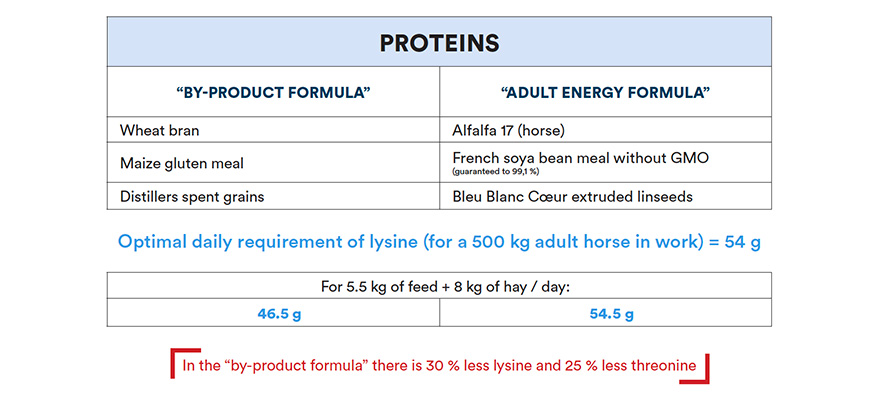
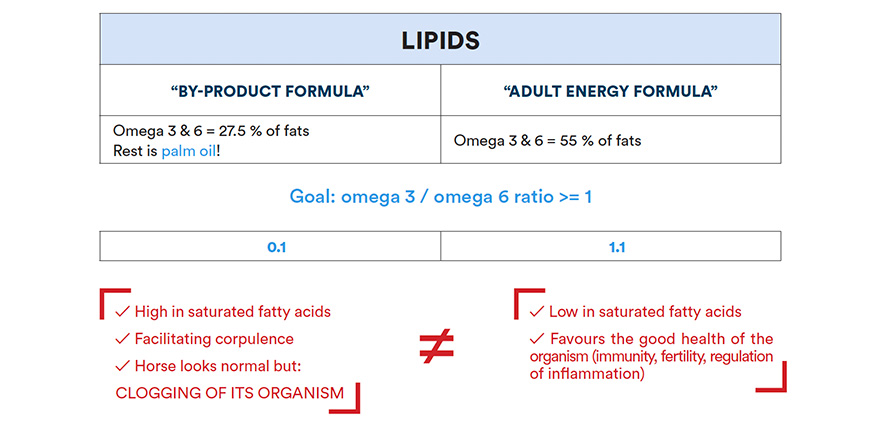
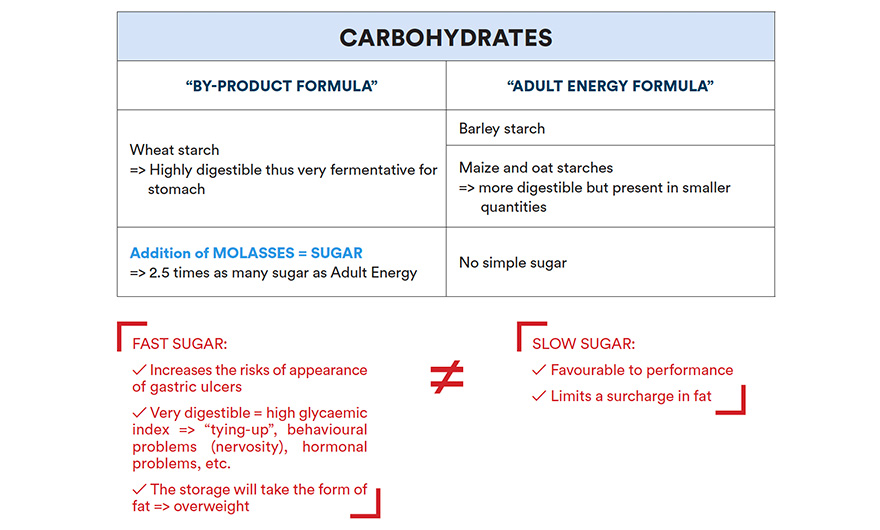
FLAKES?
> Increase digestibility thus glycaemic index of cereals.
TOO MUCH FLAKES =
- Overweight
- Development of gastric ulcers
- Behavioural problems
- Muscular problems
- Metabolic problems
We strongly advice against flakes in breeding! (for broodmares in gestation and also young growing horses). They favour the development of osteoarticular disorders in young horses.
We advise using flakes with moderation, only on specific situations.
Example: horses in hard work which require high energy.
Comparison with the human diet
A hamburger, pizza or hotdog can contain the same amount of protein, fat and energy as a plate of fish, olive oil, brown rice and green beans.
Two different diets, two different effects on our organism and our health...
We choose to compare horse diet with Human diet.
« By-product » formula = « Fast-Food » Meal
Adult Energy Formula = « Athlete » Meal
A comparison with human diet is presented below.
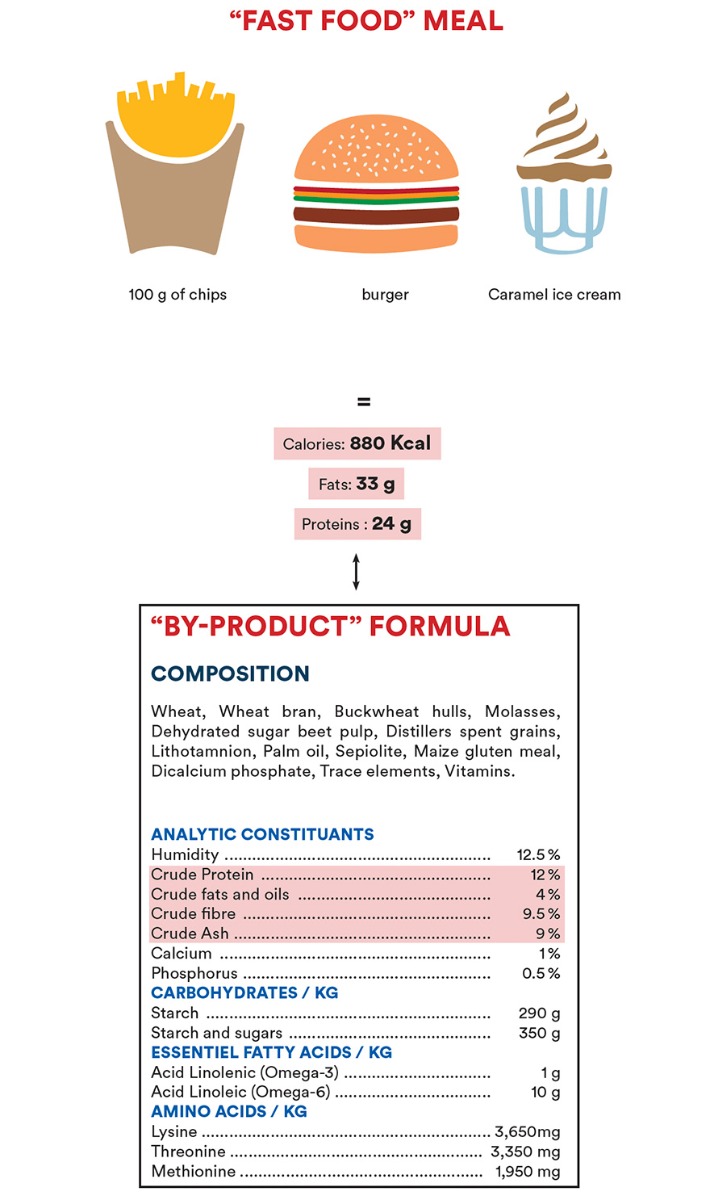
A « Fast-Food » Meal contains the same quantity of Fats (33 g) and Proteins (24 g) than a balanced meal.
However, how many athletes would choose the first meal?
